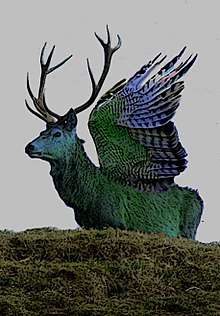Peryton
The peryton is a mythological hybrid animal combining the physical features of a stag and a bird. The peryton was created and described by Jorge Luis Borges in his 1957 Book of Imaginary Beings, using a supposedly long-lost medieval manuscript as a source.

Mythology
The peryton is said to have the head, neck, forelegs and antlers of a stag, combined with the plumage, wings and hindquarters of a large bird, although some interpretations portray the peryton as a deer in all but coloration and bird's wings.
According to Borges, perytons lived in Atlantis until an earthquake destroyed the civilization and the creatures escaped by flight. A peryton casts the shadow of a man until it kills one during its lifetime, at which time it starts to cast its own shadow. A sibyl once prophesied that the perytons would lead to the downfall of Rome.[1]
In Borges' original Spanish edition, the word is given as peritio so the presumptive Latin original would be peritius, which happens to be the Latin name of the fourth month on the ancient Macedonian calendar[2] (Peritios, moon of January). The connection of this, if any, to the peryton is unclear.
In popular culture
Perytons are found or used in modern literature and games.
Books and manga
- Monsters called 'perytons' appear in Diane Duane's Young Wizards series of young-adult fantasy novels as minions of the archvillain of the series; while their appearance and nature is very different from (and much darker than) the creatures describes by Borges, they still bear a number of conceptual similarities.
- A peryton closely matching Borges's original description is a minor villain in The Cinnabar Box, a fantasy novel by Ilil Arbel. Uniquely, this incarnation of the monster can use and understand human speech.[3]
- A peryton is referred to in The Sword of the Lictor, a book in The Book of the New Sun series by Gene Wolfe. In the series, a constellation is also named after the beast.
- The creatures also appear in Darkwell, a book in The Moonshae Trilogy, where a flock of perytons are among an army of evil monsters summoned by the book's main antagonist.[4]
- A herd of golden-furred perytons with poisonous antlers attack the main characters in the book Fablehaven: Secrets of the Dragon Sanctuary while fleeing a dragon.
- A murderous peryton named Orfeo is a major villain in the fantasy novel Whiskey and Water by Elizabeth Bear.
- Swarms of cat-sized perytons are natural enemies of the unicorns in Peter S. Beagle's fantasy novel The Unicorn Sonata.
- The peryton features in John and Carole Barrowman's novel Hollow Earth.[5]
- In the Kendra Kandlestar children's book series, perytons are somewhat arrogant and keep to themselves. They refer to earth-bound beings as "underlings," but are herbivorous and pose no threat to humans or other creatures.
- In The Outcast, a prequel to the Summoner trilogy written by Taran Matharu, a peryton is a level 9 demon favored by the Celestial Corps, and is considered the most common of the flying steeds available to Hominum's summoners.
- A peryton is one of the antagonists in the urban fantasy novel Between Frames by W.R. Gingell. The Peryton in this book is described as a stag/bird hybrid with strong magic and a biological defense system that makes them look like the last person they killed.
Games
- The peryton is included among the bestiary of the game Dungeons and Dragons. Like the creature in Borges' book, it has the hindquarters of a large bird.
- The peryton is included in the mythology-themed "Monsters of the Mind" subsection in the 2003 trading card game Weird n’ Wild Creatures.
- The peryton is one of the monsters in the Monsters and Animals supplement for the Palladium Fantasy Role-Playing Game and related games from Palladium Books, and includes the "casts the shadow of a man" aspect from Borges, although the creature is depicted as a winged deer.
- A peryton is featured in the text based phone game The Arcana in Muriel's route.
Science
- The term peryton is also used for radio signals of terrestrial origin that mimic fast radio bursts, pulses that appear to be coming from outside of our galaxy.[6] These perytons were found to be the result of premature opening of a microwave oven door, which releases a frequency-swept radio pulse, which mimics a fast radio burst, as the magnetron turns off.[7]
See also
- Peryton (Dungeons & Dragons)
- Hybrid (mythology)
References
- Nigg, Joseph (2002). The Book of Dragons & Other Mythical Beasts (1st ed.). Hauppauge, NY: Barron's. p. 91. ISBN 9780764155109.
- Περίτιος
- Arbel, Ilil (2003-09-01). "The Cinnabar Box". ISBN 9781589394698. Cite journal requires
|journal=(help) - ASIN 0786935669
- Kelly, Charles (26 January 2011). "Hollow Earth - A Great Read and Brilliant Promotion for Cumbrae". S1millport.com. Retrieved 27 January 2011.
- Sarah Burke-Spolaor; Matthew Bailes; Ronald Ekers; Jean-Pierre Macquart; Fronefield Crawford III (2010). "Radio Bursts with Extragalactic Spectral Characteristics Show Terrestrial Origins". The Astrophysical Journal. 727: 18. arXiv:1009.5392. Bibcode:2011ApJ...727...18B. doi:10.1088/0004-637X/727/1/18.
- Emily Petroff; E. F. Keane; E. D. Barr; J. E. Reynolds; J. Sarkissian; P. G. Edwards; J. Stevens; C. Brem; A. Jameson; Sarah Burke-Spolaor; S. Johnston; N. D. R. Bhat; P. Chandra; S. Kudale; S. Bhandari (2015). "Identifying the source of perytons at the Parkes radio telescope". Monthly Notices of the Royal Astronomical Society. 451: 3933–3940. arXiv:1504.02165. Bibcode:2015MNRAS.451.3933P. doi:10.1093/mnras/stv1242.